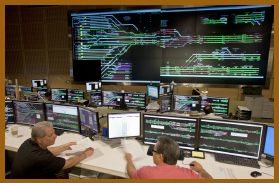

ED KOCH WAS STILL THE MAYOR IN 1988. Attempts to enforce a curfew in Tompkins Square Park on the Lower East Side resulted in a “police riot” that sparked scores of complaints about brutality. Phantom of the Opera opened on Broadway. Cher won an Oscar for Moonstruck. Smoking was banned on short-hop domestic flights. The White House acknowledged that Nancy Reagan relied on astrological advice to arrange the president’s schedule. The Supreme Court upheld a New York City law barring private clubs from generally excluding women and minorities. And on April 6, at Control Point No. 212 on Track 4, a mile west of the Mount Vernon station, an eight-car New Haven train traveling from Grand Central to Connecticut to pick up morning rush-hour passengers slammed into another deadhead, a five-car train that was stopped while overhead catenary power lines were being repaired. Railroad officials blamed human error for the crash, in which the 42-year-old engineer, who had received no previous moving violations, was killed. It was the first and last fatal crash in a nearly three-decade history of Metro-North.
The system’s 795 miles of track (covering routes stretching 385 miles) are controlled from a secure command center on the sixth floor of Grand Central (in case of any damage or threat to the terminal, a duplicate operations center can be up and running at an undisclosed location). A nondescript door at the back of the center opens onto a narrow, dank shaft, which provides access to the rose-colored stained-glass clock that fronts on 42nd Street. The juxtaposition of the two rooms makes for a stark contrast. The clock ticks in a grimy, rough-hewn chamber illuminated by bare bulbs and accessible only by several rickety ladders. On the other side of the door, two 9-by-30-foot video screens, each two stories tall, can display the location of every train on every track or zoom in to pinpoint problem areas. A dozen railroad traffic controllers staff two banks of computer terminals, each monitoring a specific geographic area.
Until 1983, when the system was modernized and automated (it was consolidated at Grand Central in 1998 and renovated again in 2010), it took 108 workers per shift to perform the same function. John Kroll is the chief of operations, overseeing a system that dispatches one train every 30 seconds on each of four tracks during the three-hour “rush hours” and as many as 700 on a single day.
As long ago as 1922, transit officials proposed a new suburban station at Park Avenue and 32nd Street to relieve Grand Central and Pennsylvania Station, but the decline of long-distance traffic eased pressure on the 66 Upper Level tracks 15 feet below street level and the 57 tracks on the Lower Level, 26 feet farther down. The operations center also handles Amtrak trains from Spuyten Duyvil to Poughkeepsie and from New Rochelle to New Haven, CSX freight trains that use the Metro-North tracks (some actually terminate in Grand Central), and work trains (including the garbage train that leaves from Track 14).
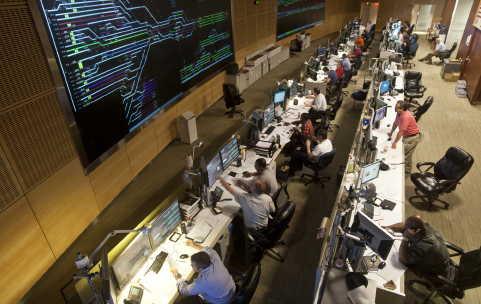
A DOZEN CONTROLLERS PLUS SUPERVISORS STAFF TWO BANKS OF COMPUTER TERMINALS, EACH MONITORING A DISTINCT GEOGRAPHIC AREA.
General Railway Signal Company built the system, which tracks trains by a low-voltage current that completes a circuit as the wheels of the train pass over. Platforms at the railroad’s 121 stations appear on the screens as yellow rectangles—lots of them on the left side of the double screen, which depicts the Grand Central train yards, where the “ladder” of tracks funnel into the four north of 59th Street (the Harlem and New Haven lines split off in the Bronx at Woodlawn, and the Hudson at Mott Haven). An occupied track appears in red. A three- or four-digit number identifies the direction of the train and its station of origin. Control points are where trains can switch from one track to another, and a column headed by a red bar lists trains that are running late, so that their routes can be rejiggered around detours or other trains to get them on time again (one reason that Metro-North boasts a 98 percent on-time record, defined by the industry standard as within 5 minutes and 59 seconds of the timetable). Visual and audible indicators in locomotive cabs signal engineers when to slow down or stop. If they fail to respond to a red signal, the air brakes automatically stop the train. The maximum speed limit is 79 mph.
“There is no possible way to override the system, and there has been no crash since this system was put in place,” Kroll said, in one of those knock-wood conversations. “There is always the possibility of human error, but it would take a calamity of errors by a lot of humans for it to happen to this system. It’s foolproof. A crash is impossible.”
ROBERT P. SARACENI, a civil engineer with a master’s in business who retired in 2011 as general superintendent of the terminal, oversaw the mail room, maintenance people and other services, including the information booth (which used to be staffed 24 hours a day to answer “all that the stranger may ask about New York”; one man who demanded “What time does the last train leave?” was stunned by the reply: “You should live so long”). The superintendent sees to it that the temperature hovers around a constant 75 degrees (although the mercury can approach 120 degrees in the summer on some train platforms).
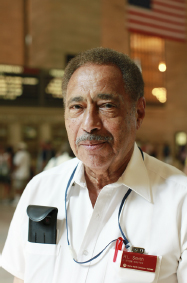
R.L. SMITH OF QUEENS RETIRED IN 2011 AS A STATIONMASTER. HE HAD WORKED AT GRAND CENTRAL FOR 62 YEARS.
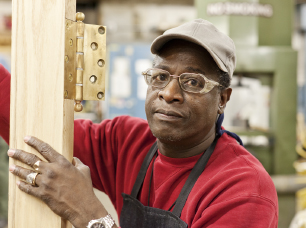
ISAAC BLAIR, A CARPENTER, BUILT A NEW SOLID OAK DOOR FOR THE TERMINAL THAT HE HUNG ON THE ORIGINAL BRASS HINGES.
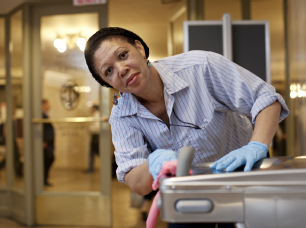
ABOUT 600 METRO-NORTH EMPLOYEES WORK AT THE TERMINAL, INCLUDING TICKET SELLERS, USHERS, AND CLEANERS, LIKE CORDALEE ALLEN.

GIUSEPPE D’AMBROSIO, A MASON, DISPLAYS A SLAB OF THE SPECIALLY QUARRIED TENNESSEE MARBLE TO FIX THE CONCOURSE FLOOR AND WALLS.

GRAND CENTRAL’S FULL-TIME CRAFTSMEN INCLUDE FRANK SPITALERI, A MACHINIST. THE LATHE IS A TERMINAL ORIGINAL.

DANNY SANT HELPED MAINTAIN THE TERMINAL’S MASSIVE ARRAY OF STEAM LINES AND OTHER UTILITIES.
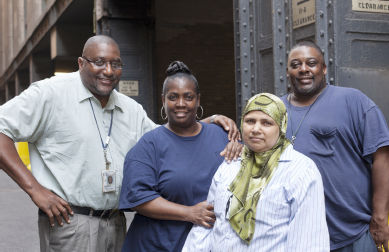
THEY DELIVER: ERIC HARRIS, VALERIE GRAND, FARIDA SULTANA, AND WAYNE DABBS HANDLE THE LOADING DOCK AT DEPEW PLACE.

NICK GIAMONNA (RIGHT) IS THE CHIEF ENGINEER OF THE TERMINAL’S SERVICE PLANT, ASSISTED HERE BY MANNY OJEDA.
About 20 members of Grand Central’s volunteer fire brigade—otherwise ordinary people who work in the terminal (seven others are paid)—respond to hundreds of emergencies a year by foot or in four suped-up golf carts equipped with flashing red lights. Among the volunteers is Jade Hargraves, who works in the information booth on the Main Concourse. She originally signed up for the brigade’s first aid course to respond to emergencies in her own family. “I have one child,” she said. “He’s the reason I started C.P.R. in the first place. He thinks it’s real cool that his mom is a firefighter/E.M.T.”

SAL OLIVA (RIGHT) IS CHIEF OF THE FIRE BRIGADE. EMERGENCY MEDICAL VOLUNTEERS AND FULL-TIME EMPLOYEES INCLUDE JONATHAN LEE, SANDRA NIXON, DUNG HOAI DINH, AND ANTHONY LAMANNA.
The police force at Grand Central is 80 strong. Under Conrail, it was headed by a woman, Captain Dorothy Schulz, for the first time, in 1979. From the days of “Grand Central Pete” on, the terminal’s law enforcement team has been deployed against hucksters, swindlers, pickpockets, and more serious threats and circumstances. George P. Metesky, the 53-year-old former Con Edison worker from Waterbury, Connecticut, who began a terror streak in 1940 as the “Mad Bomber,” targeted Grand Central five times until he was captured in 1957.
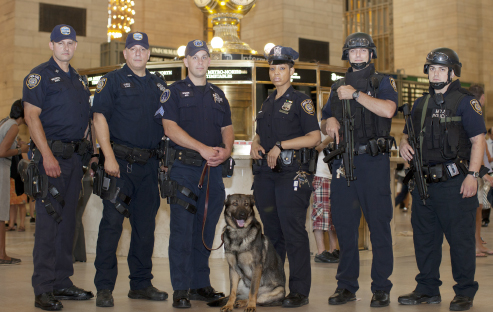
OFFICERS JAMES NICASTIO AND DOMINGO OJEDA, SERGEANT WILLIAM SCHADE, AND OFFICERS PARTI STARKS, ANTHONY FAZIO, AND DAVID STEIBLE, WITH DOOLEY OF THE K-9 UNIT.
On September 11, 1976, Croatian nationalists who planted a bomb in a coin locker provided instructions for disarming it, but the operation went awry, wounding 30 people and killing a New York City Police Department bomb squad expert. In 1983, a bank robbery by a hatchet-wielding man was foiled, but a bank guard’s gun accidentally discharged, causing a panic. Gunfire erupted again in 1990 when police wounded a burglary suspect as he got off a train. The last reported murder in greater Grand Central was in the subway, in 1988, when a 38-year-old man was charged with shooting his former companion.
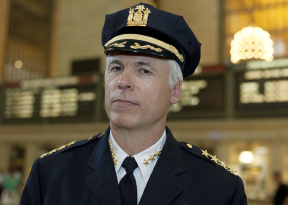
MICHAEL R. COAN IS CHIEF OF THE MTA POLICE, WHICH INCLUDES DISTRICT 5–GRAND CENTRAL.
Michael R. Coan, chief of the MTA Police (which absorbed the Metro-North force in 1998), says most of the incidents handled by District 5—his Grand Central cops—are “aided cases,” when passengers or passersby get sick. His force arrests about 100 people a year, mostly for shoplifting or petty theft.
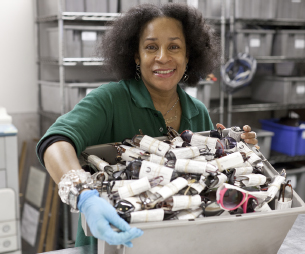
SOME 25,000 ITEMS ARE TURNED IN ANNUALLY TO GRAND CENTRAL’S LOST AND FOUND OFFICE, WHERE REPOSITORIES INCLUDE A BIN LUGGED BY VALERIE BLANCHARD AND OVERFLOWING WITH EYEGLASSES.
IN 2011, railroad employees and passengers turned in 24,691 items to Grand Central’s Lost and Found office. By the end of the year, 13,126—more than half—were reunited with their owners. In any given year, the items typically lost by passengers and found by fellow riders or railroad workers include 3,000 coats and jackets (they’re stored on a mechanized rack, the kind found in dry-cleaning stores), 2,500 cell phones, 2,000 sets of keys, 1,500 wallets or purses, 1,100 umbrellas, countless eyeglasses, and enough books to stock a small library.
The list of atypical items is considerably shorter but borders on the bizarre: a pet beagle who wandered off and boarded a southbound train at Crestwood, artificial limbs (usually from patients at the veterans’ hospital in Montrose), $9,999 in cash stuffed into a pair of socks, a neck brace, a hockey stick, dentures, and a living will, lost by a mother whose daughter was about to have open-heart surgery (a frantic search found the document before the operation began).
A silver vase found on a seat wins the prize for weirdest abandoned item, hands down. Terminal officials say that it turned out to have been left deliberately by a widow whose husband claimed a few too many times that he came home late because he had been stuck on a train. The vase contained his ashes, and his wife figured leaving them on a train indefinitely was just retribution. She finally retrieved the vase a few weeks later.
Mike Nolan supervises a staff that tries mightily to reunite lost items with their owners. Meticulous cataloging guarantees that as many as 80 percent of lost items are eventually returned, particularly laptop computers, which contain tantalizing hints. Identifying the elusive owner by examining his desktop files, said Nolan’s predecessor, Frederick Chidester, a former police lieutenant, “I can see that he’s a lawyer, he’s got a big pharmaceutical company involved in a lawsuit against him, and he’s got a case pending in Superior Court in Westchester. We can track it down by going through the court docket to find out what cases are pending against that company, and then we might find a name that matches with the lawyer on the defendant’s side.”
Precise descriptions of items deposited in collection bins at local stations or in the Lost and Found office on the Lower Level of Grand Central are typically entered into an inventory database, including the date, time, train number, and even seat number where the item was discovered. If an item is not retrieved after 90 days, it is likely to be donated to charity or sold. Expensive items are placed in a safe and are kept longer, sometimes for years.
“There are a lot of people who lose things that shouldn’t be lost,” Chidester said, including drug couriers, some of whom return for their missing bags only to be arrested. “It’s not a case of trickery,” Chidester said. “It’s a case of stupidity.” Pretty much the same can be said for another type of customer, who’s hoping to find something that someone else lost. “We can recognize a ‘shopper’ because they are not sure when they lost something, where they lost it, or what, exactly, it was they lost.”
Audrey Johnson, a 55-year-old commuter from Stamford who collects teddy bears (she had 1,033 at last count), has worked for the railroad since 1979, first as a Conrail police officer (she majored in criminology) and since 1989 cheerfully fielding questions in the information booth and the stationmaster’s office as a customer service representative. She defines customer service broadly, once even following a passenger’s directions to inject him with insulin as he suffered diabetic shock.
The question people ask most, she said, is “How do I get out of the building?” The second, predictably, is “Where is the bathroom?”
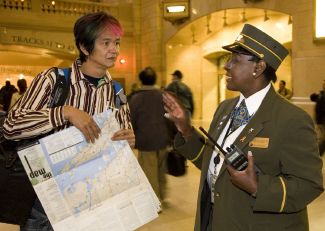
ALWAYS SERVING CUSTOMERS: AUDREY JOHNSON.